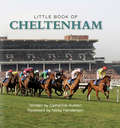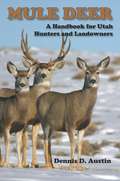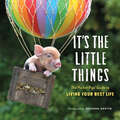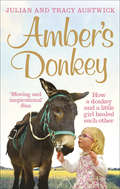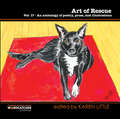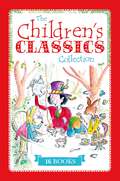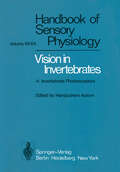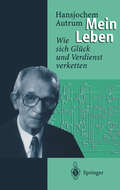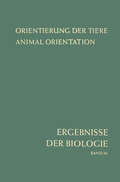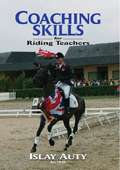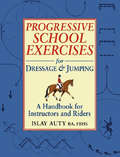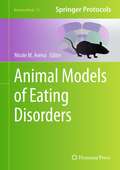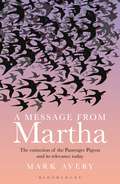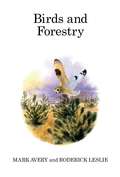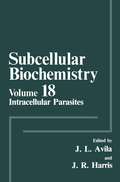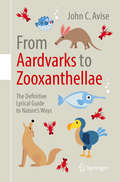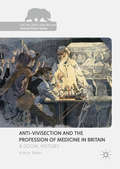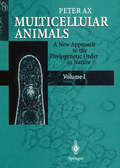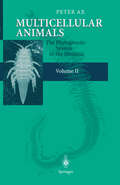- Table View
- List View
Probiotics in Aquaculture
by Brian Austin S. M. SharifuzzamanThis book has been developed to provide a detailed discussion of probiotics, which have been evaluated for use predominantly in fish and shellfish aquaculture. This book highlights strengths and weaknesses in knowledge and discusses gaps that need to be addressed. There has been a great deal of research concerning the use of probiotics in aquaculture. To date, a wide range of Gram-positive and Gram-negative bacteria and some eukaryotes, i.e. yeasts and unicellular algae, has been reported to be beneficial to aquatic hosts. Following oral uptake, benefit includes improved growth performance and protection against many bacteria and some parasitic diseases. This book will be suitable for scientists, veterinarians, professionals, and senior students involved in aquaculture.
The Little Book of Cheltenham (Little Bks.)
by Catherine AustinFor fans, National Hunt racing has only one home: Cheltenham. The racecourse, which occupies a perfect natural amphitheatre with Cleeve Hill as a dramatic backdrop, is frequently described as 'the theatre of dreams'. The four-day Festival in March has become the pinnacle of ambition for trainers, jockeys and owners. To win there is everything. For punters, months of speculating, planning and wagering climax in fortunes won or lost. Horse-lovers watch, hearts racing, as their favourites soar over the birch and gallop up the famous hill to the finish. The passion expressed in the roar as the tapes go up for the first race of the meeting epitomises how they all feel about Cheltenham. The Little Book of Cheltenham explores the history of this iconic racecourse and charts its progression from the first Gold Cup – a Flat race run on Cleeve Hill in 1819 – to the 2014 redevelopment . From Golden Miller, Arkle and Vincent O'Brien to Best Mate, Ruby Walsh and Sam Waley-Cohen, we meet some of the characters – equine and human – who have become Cheltenham heroes, and go behind the scenes to discover how the heart of jumping racing operates. The foreword is by Cheltenham legend, Nicky Henderson.
Mule Deer: A Handbook for Utah Hunters and Landowners
by Dennis D. AustinA complete guide to the history, biology, hunting, and management of mule deer in Utah. The author, Dennis D. Austin, is a retired research scientist with more than thirty years of experience working as a wildlife biologist for the Utah Division of Wildlife Resources.
It's the Little Things: The Pocket Pigs' Guide to Living Your Best Life (Inspiration Book, Gift Book, Life Lessons, Mini Pigs)
by Richard AustinAn adult gift book of wisdom for living well and enjoying the small things in life, featuring the beloved tiny teacup pigs of Pennywell Farm.
Amber's Donkey: How a donkey and a little girl healed each other
by Julian Austwick Tracy Austwick‘The first time Shocks saw Amber coming, he lowered his head so she could wrap her arms around his nose. It was as if they understood each other’s pain. Like two broken beings, helping each other.’ When Shocks the donkey was left for dead on a farm in Ireland, no one ever thought he would make a full recovery. When Amber and her twin sister Hope were born 26 weeks premature, it was Amber who was separated from her family and rushed into theatre for an emergency tracheostomy. Her parents were given the devastating news that she had Cerebral Palsy and would be unlikely to walk or talk. Then Amber met Shocks at the Donkey Sanctuary and their lives were changed for good. This is their touching story of recovery through friendship.
Mechanisms of Platelet Activation and Control (Advances in Experimental Medicine and Biology #344)
by Kalwant Authi Stephen Watson Vijay V. KakkarRecent years have seen tremendous advances in our understanding of the molecular mechanism of platelet activation. All aspects of signal transduction in platelets from the identification of surface receptors, G proteins, phospholipases, protein kinases and phosphatases, intracellular receptors for inositol phosphates, the Ca2+ regulatory machinery, cytoskeletal constituents to the control mechanism employing cyclic nucleotides has seen an explosion of information regarding their importance and for each constituent in the family of molecules to which they belong. This information has been of interest to researchers across a wide spectrum of disciplines including biochemists, pharmacologists, cell biologists and clinicians. In April 1992 an International Symposium bearing the name of this volume was organised at the Thrombosis Research Institute to bring together scientists from across the world whose common interest was the study of platelet activation and its regulation. We were particularly encouraged by the positive response from our speakers and the participants, their detailed contributions and the very lively discussions that took place throughout the two days of the symposium. Almost every aspect of signal transduction in human platelets was represented. Of the invited speakers twelve were from Europe (including the U. K. ), eight from North America and one from Japan. This volume is a compilation of chapters submitted by the speakers and represents a concise but informative picture of the present knowledge of the mechanisms of platelet activation and control.
Art of Rescue: An anthology of poetry, prose and illustrations (Creative Portfolio Series #17)
by Various AuthorsEight writers weave words about their rescue pet, in poetry or prose. I hope in bringing together my drawings of adopted pets and their stories, we can demonstrate how wonderful shelter pets are. All author royalties from the sale of this book will be donated to the animal shelter EPAT.
The Children's Classics Collection: 16 of the Best Children's Stories Ever Written
by Various Authors Stewart Ross Saviour PirottaAbridged and retold in modern English by respected children's authors, this collection of sixteen classic stories makes them accessible to readers as young as six, while retaining all the charm, atmosphere, and sense of adventure that made the original tales world-famous. These dramatic, easy-to-follow stories, charmingly illustrated with verve and humour by specially commissioned artists, deserve to find a home on every child's bookshelf.Included in this boxed set:1. Alice in Wonderland2. Treasure Island3. The Wizard of Oz4. The Jungle Book5. The Secret Garden6. Robin Hood7. Peter Pan8. Heidi9. Anne of Green Gables10. Little Women11. Black Beauty12. The Call of the Wild13. Robinson Crusoe14. Wind in the Willows15. Tom Sawyer16. Oliver Twist
Comparative Physiology and Evolution of Vision in Invertebrates: A: Invertebrate Photoreceptors (Handbook of Sensory Physiology #7 / 6 / 6 A)
by H. Autrum M. F. Bennet B. Diehn K. Hamdorf M. Heisenberg M. Järviletho P. Kunze R. Menzel W. H. Miller A. W. Snyder D. G. Stavenga M. YoshidaIn the comparative physiology of photoreception by the Protista and the invertebrates two aspects are emphasized: (1) the diversity of visual processes in these groups and (2) their bearing upon general mechanisms of photoreception. Invertebrates have evolved a far greater variety of adaptations than vertebrates modifications aiding survival in the remarkably different biotopes they occupy. The number of species in itself suggests this multiformity; each of them has peculiarities of its own, in morphology as well as in physiology and behavior. But these special adaptations are variations on a few great themes. Although the catalogue of invertebrate species is immense, the literature concerning them nearly rivals it in extent-even if one considers only that fraction dealing with visual physiology. Taxonomy proceeds by grouping the species, categorizing them in genera, families, orders, and progressively larger units. Similarly, comparative physiology aims at an analogous, more or less compre hensive, classification. This Part A of Volume VII/6, like Part B that follows it, emphasizes the broad questions that concern groups larger than the individual species; in some cases these questions have general applicability. The middle course between approaches that are too specialized and those that are too general is often elusive, but here we attempt to follow it. The vast number of special adaptations-probably, as we have said, as large as the number of species-is beyond the range even of a handbook.
Hansjochem Autrum: Wie sich Glück und Verdienst verketten
by Hansjochem AutrumHansjochem Autrum, einer der Begründer der vergleichenden Sinnesphysiologie und einer der großen deutschen Zoologen dieses Jahrhunderts, legt hier seine wissenschaftsgeschichtlich und menschlich höchst interessante Autobiographie vor.Anschaulich berichtet der Autor von seinem beruflichen Werdegang und von seiner Forschungs- und Lehrtätigkeit an verschiedenen deutschen Universitäten, an deren Wiederaufbau und z.T. Gründung er maßgeblich beteiligt war. Er erzählt von den Menschen, denen er im Laufe seines Lebens begegnet ist und mit denen er zusammen gelebt und gearbeitet hat, von seiner Familie, von Freunden, Kollegen, Vorgesetzten und Mitarbeitern, stets wohlwollend, doch oft mit humorvollem Augenzwinkern.
Orientierung der Tiere / Animal Orientation: Symposium in Garmisch-Partenkirchen 17.–21. 9. 1962 (Ergebnisse der Biologie Advances in Biology #26)
by Hansjochem Autrum Erwin Bünning Karl v. Frisch E. Hadorn A. Kühn E. Mayr A. Pirson J. Straub H. Stubbe W. WeidelCOACHING SKILLS FOR RIDING TEACHERS
by Islay AutyThis book focuses on the skills of coaching rather than how to teach the actual skills of riding. In true Islay Auty style this book is easy to read and hard to put down. It's packed full of useful, easy to find information, making it perfect for anyone who is thinking of, or already training for the UK Coaching Certificate in Equestrian Sport, as well as anyone who is newly qualified or still studying for their teaching certificate. --The British Horse Society The book is written in an interactive style with thought provoking questions embedded into each chapter, such as When you ask a question, do you listen to the answer? At the end of each chapter is a useful summary and top tips. Also various scenarios or case studies are used for further explanation. Coaching Skills is written for riding teachers who wish to enhance their teaching skills, especially for those who are newly qualified or still studying for their teaching certificate. In particular, this book provides excellent reading for those seeking to achieve the UK Coaching Certificate in Equestrian Sport. An interesting and thought- provoking read. --National Equine Student Magazine
PROGRESSIVE SCHOOL EXERCISE FOR DRESSAGE AND JUMPING
by Islay AutyThis text aims to provide a collection of exercises, on the flat and over fences, specifically designed for use in training more experienced riders and horses, whether in groups or as individuals, or schooling at home. Specially chosen ridden exercises aim to improve: in the horse - rhythm, impulsion, balance, elasticity, straightness, athleticism, suppleness, obedience and self-carriage. In the rider - balance, effectiveness, accuracy, co-ordination, forward planning, feel, and the ability to see a stride when jumping. The book is divided into groups of related exercises, each accompanied by a full description, the relevant aids, teaching hints, and advice on remedying typical faults. Exercises include: loops and circles; movements with transitions; work on diagonal lines; moving away from the leg; leg yield; developing canter; counter canter; shoulder-in; jumping exercises over grids, doubles and related distances. This book is the follow-up to "School Exercises for Flatwork and Jumping".
Animal Models of Eating Disorders (Neuromethods #74)
by Nicole M. AvenaThe growth of the field of eating disorder research has led to a vast array of empirical articles, and the development of new animal models that can be used to study these disorders continues to stimulate new research. Animal Models of Eating Disorders serves as a collection of detailed techniques contributed by experts in the field who are well-versed in the development and implementation of these models. Since eating disorders are complex and likely due to a combination of environmental, genetic, and social causes, the detailed chapters of this volume have been designed to highlight different contributing factors. Collectively, these chapters give a comprehensive and representative overview of both recently developed and classic methodologies used in the study of eating disorders. Written for the popular Neuromethods series, this work contains the kind of thorough description and implementation advice that promises successful results. Authoritative and practical, Animal Models of Eating Disorders aims to aid researchers in the use of animal models to assist in their investigation and characterization of the behaviors and neurochemical alterations associated with these devastating disorders.
A Message from Martha: The Extinction Of The Passenger Pigeon And Its Relevance Today (Bloomsbury Nature Writing Ser.)
by Mark AverySeptember 1st, 2014 marked the centenary of one of the best-documented extinctions in history – the demise of the Passenger Pigeon. From being the commonest bird on the planet 50 years earlier, the species became extinct on that fateful day, with the death in Cincinnati Zoo of Martha – the last of her kind. This book tells the tale of the Passenger Pigeon, and of Martha, and of author Mark Avery's journey in search of them. It looks at how the species was a cornerstone of the now much-diminished ecology of the eastern United States, and how the species went from a population that numbered in the billions to nil in a terrifyingly brief period of time. It also explores the largely untold story of the ecological annihilation of this part of America in the latter half of the 19th century, a time that saw an unprecedented loss of natural beauty and richness as forests were felled and the prairies were ploughed, with wildlife slaughtered more or less indiscriminately. Despite the underlying theme of loss, this book is more than another depressing tale of human greed and ecological stupidity. It contains an underlying message – that we need to re-forge our relationship with the natural world on which we depend, and plan a more sustainable future. Otherwise more species will go the way of the Passenger Pigeon. We should listen to the message from Martha.
Birds and Forestry (Poyser Monographs)
by Mark Avery Roderick LeslieThe conflict between forestry and nature conservation has, in recent years, become a major environmental issue. The planting of large tracts of land with exotic conifers and the resulting disturbance of existing plant and animal communities has polarized the debate, each camp believing that it holds the most rational view. This book tackles the issues, and represents a step toward achieving prudent land planning.
Birds and Forestry (Poyser Monographs #90)
by Mark Avery Roderick LeslieThe conflict between forestry and nature conservation has, in recent years, become a major environmental issue. The planting of large tracts of land with exotic conifers and the resulting disturbance of existing plant and animal communities has polarized the debate, each camp believing that it holds the most rational view. This book tackles the issues, and represents a step toward achieving prudent land planning.
Intracellular Parasites (Subcellular Biochemistry #18)
by José-Luis Avila J. Robin HarrisVolume 18 of the Subcellular Biochemistry series, which specializes in various aspects of the biochemistry of the intracellular parasites, was initially proposed by Jose Luis Avila and strongly supported by myself, as Series Editor of Sub cellular Biochemistry. Considerable assistance was received from Professor Frank Wunderlich (University of Dusseldorf) and more particularly from Dr. Michael Miles (London School of Hygiene and Tropical Medicine) during the compilation of the list of possible chapters. Our initial aim was to present a comprehensive survey of this broad field of study. Although some interesting topics have been lost due to authors backing out late in the production schedule of the book, the manuscripts that were submitted have provided a useful over view of the subject, with notable strength within the field of Leishmania. The 13 chapters of the book have been grouped according to subject. The first five chapters deal with Leishmania and are followed by two chapters on Try ponosoma cruzi, two on the malarial parasites, and two on the Coccidia. The fmal two chapters cover the Microsporidia and chemotherapy, respectively.
Molecular Markers, Natural History and Evolution
by J. C. AviseMolecular approaches have opened new windows on a host of ecological and evolutionary disciplines, ranging from population genetics and behavioral ecology to conservation biology and systematics. Molecular Markers, Natural History and Evolution summarizes the multi-faceted discoveries about organisms in nature that have stemmed from analyses of genetic markers provided by polymorphic proteins and DNAs. The first part of the book introduces rationales for the use of molecular markers, provides a history of molecular phylogenetics, and describes a wide variety of laboratory methods and interpretative tools in the field. The second and major portion of the book provides a cornucopia of biological applications for molecular markers, organized along a scale from micro-evolutionary topics (such as forensics, parentage, kinship, population structure, and intra-specific phylogeny) to macro-evolutionary themes (including species relationships and the deeper phylogenetic structure in the tree of life). Unlike most prior books in molecular evolution, the focus is on organismal natural history and evolution, with the macromolecules being the means rather than the ends of scientific inquiry. Written as an intellectual stimulus for the advanced undergraduate, graduate student, or the practicing biologist desiring a wellspring of research ideas at the interface of molecular and organismal biology, this book presents material in a manner that is both technically straightforward, yet rich with concepts and with empirical examples from the world of nature.
From Aardvarks to Zooxanthellae: The Definitive Lyrical Guide to Nature’s Ways
by John C. AviseHundreds of animal species provide the cast of characters for these newly composed bio-limericks, arranged into 17 chapters by taxonomic group (such as Birds, Fishes, Insects) or biological subject (such as Ecology, Genetics, and Anthropology). Sometimes multiple verses on one organism or topic provide an extended story-line across successive poems. In addition, several stylistic vignettes recur throughout the book, such as: (a) “On the Farm”, which ranges from barnyards to fish farms to oyster farms; and (b) “Let’s Play Jeopardy”, where the reader guesses an animal from poetic clues the author provides. Each little jingle can be read as a stand-alone offering a quick chuckle or biological insight. But watch out—these poetic tidbits can be as addictive as popcorn, such that some readers will feel compelled to consume each chapter and indeed the entire book at one sitting! Covering nearly every creature that any amateur or professional biologist has ever heard of, these pun-filled limericks provide humorous insight into each critter or its peculiar habits, in a sharply witty and cutely informative way.
Principles of Wildlife Conservation
by Ankur AwadhiyaWildlife tend our forests — they pollinate flowers, disperse seeds, eat insects that harm trees, and keep herbivores and diseases in check. They keep our forests healthy and resilient — ready and able to face and counter any challenges — such as global warming and climate change. They are the individual cogs that keep the forest machine functioning. And we desperately need our forests — to sequester carbon, to purify our air and water, to protect our soils from getting eroded, and to save our dams and waterways. Wildlife do need our care, concern and attention, but we also need our wildlife — perhaps much more sincerely. A majority of wildlife arrived on this planet much before humans, and the Earth belongs to them as well. So how do we conserve wildlife? This is the question that Principles of Wildlife Conservation seeks to answer. It presents a lucid — cogent yet simple narration about the why's and how's of conserving wildlife. It begins with the first principles — and thus requires no more prerequisite than an urge to seek knowledge. It is full of pictures and case studies from the field — to facilitate easy grasping of the subject. The book builds a solid foundation of the theory of wildlife conservation, and tops that up with experiences from actually doing wildlife conservation. In this way, it equips the reader to master both the science, and the art, of conserving wildlife.
Principles of Wildlife Conservation
by Ankur AwadhiyaWildlife tend our forests — they pollinate flowers, disperse seeds, eat insects that harm trees, and keep herbivores and diseases in check. They keep our forests healthy and resilient — ready and able to face and counter any challenges — such as global warming and climate change. They are the individual cogs that keep the forest machine functioning. And we desperately need our forests — to sequester carbon, to purify our air and water, to protect our soils from getting eroded, and to save our dams and waterways. Wildlife do need our care, concern and attention, but we also need our wildlife — perhaps much more sincerely. A majority of wildlife arrived on this planet much before humans, and the Earth belongs to them as well. So how do we conserve wildlife? This is the question that Principles of Wildlife Conservation seeks to answer. It presents a lucid — cogent yet simple narration about the why's and how's of conserving wildlife. It begins with the first principles — and thus requires no more prerequisite than an urge to seek knowledge. It is full of pictures and case studies from the field — to facilitate easy grasping of the subject. The book builds a solid foundation of the theory of wildlife conservation, and tops that up with experiences from actually doing wildlife conservation. In this way, it equips the reader to master both the science, and the art, of conserving wildlife.
Anti-Vivisection and the Profession of Medicine in Britain: A Social History (The Palgrave Macmillan Animal Ethics Series)
by A.W.H. BatesThis book is open access under a CC BY 4.0 license.This book explores the social history of the anti-vivisection movement in Britain from its nineteenth-century beginnings until the 1960s. It discusses the ethical principles that inspired the movement and the socio-political background that explains its rise and fall. Opposition to vivisection began when medical practitioners complained it was contrary to the compassionate ethos of their profession. Christian anti-cruelty organizations took up the cause out of concern that callousness among the professional classes would have a demoralizing effect on the rest of society. As the nineteenth century drew to a close, the influence of transcendentalism, Eastern religions and the spiritual revival led new age social reformers to champion a more holistic approach to science, and dismiss reliance on vivisection as a materialistic oversimplification. In response, scientists claimed it was necessary to remain objective and unemotional in order to perform the experiments necessary for medical progress.
Multicellular Animals: A new Approach to the Phylogenetic Order in Nature Volume 1
by Peter AxNo one can ever have secure knowledge about the gods and creatures, and should anyone hit by chance upon the right thing, he will not know it for sure; that is why everything that we believe to be true is "opinion". XENOPHANES around 500 B.C. (According to ROD 1988, p.85) The goal of phylogenetic systematics (cladistics) is to discover the kinship relations between all organisms on earth and to translate the order we perceive in Nature into an equivalent man-made system. Although the goal is easily formulated, the path is thorny, and the results achieved continue to be imperfect. This is the fate of any science that bases its propositions on the interpretation of histor ical evidence. The diversity found in the millions of species originated as a result of the continuous splitting of biopopulations through time. Combined with this was the emergence of hierarchically linked des cent communities of species. We call the process of origin of descent communities phylogenesis. We do not know, however, the exact course of phylogenesis - we can only formulate hypotheses. The historical evidence at hand consists of the feature patterns of extant species and of extinct species with their combination of original and derived traits which are the result of evolution.
Multicellular Animals: Volume II: The Phylogenetic System of the Metazoa
by Peter AxThe system of multicellular animals presented here is an alternative to the traditional classification system. In a new approach to the phylogenetic order, this book strives for an objective systematization of the metazoa, seeking a new path in the field of academic research and teaching.

